.
Mysteries of Coral Castle
.
Mysteries of Coral Castle
.
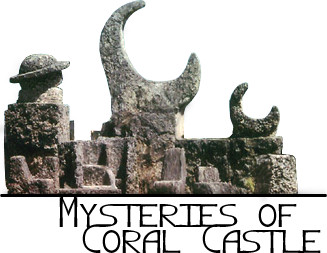
Article and photos by Frank Joseph
Reprinted with permission from FATE
In 1993 I went searching for Florida's and perhaps the world's most bizarre place. I had seen the strange complex known as Coral Castle on a television documentary, and my curiosity was aroused. Since I was already in Florida for a book convention, I decided to combine business with investigation.
I drove south on Highway 1 toward Homestead, where Coral Castle is located. The town is better known as the focal point for Hurricane Andrew, the worst tropical storm in U.S. history. Even though this natural catastrophe had occurred a full two years before, dramatic evidence of its impact was still visible from the highway. On the way, through Princeton, Naranja, and Leisure City, there were lingering reminders of the disaster.
The shell of what used to be a bank stood beside a roped-off supermarket, its roof buckling under the impossible burden of an upside-down semi-trailer truck. Block after block, private homes, mostly little brick bungalows, were individually smashed almost beyond recognition, as though by some giant's hammer. No structure stood undamaged. And numerous heaps of unidentifiable rubble shoveled together by relief workers were all that remained of many buildings. Mile after mile, south Florida resembled an atomic bomb testing site.
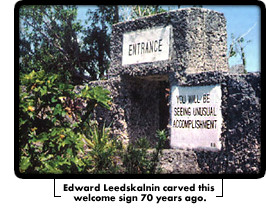 The devastation increased the closer to Homestead
I got. I assumed Coral Castle had been badly damaged by the storm, if
not obliterated. Homestead had taken the brunt of Hurricane Andrew's
fury. Although violent desolation lay at the castle's very gates, however,
the peculiar site stood intact, the only structure untouched by the
swirling carnage.
The devastation increased the closer to Homestead
I got. I assumed Coral Castle had been badly damaged by the storm, if
not obliterated. Homestead had taken the brunt of Hurricane Andrew's
fury. Although violent desolation lay at the castle's very gates, however,
the peculiar site stood intact, the only structure untouched by the
swirling carnage.But what is Coral Castle, and how could it have defied a cataclysm that devastated everything around it for thousands of square miles? The fortress-like complex is constructed of massive coral blocks, many of which exceed five tons. These are imaginatively arranged and fit together to form a central courtyard surrounded entirely by dominating walls.
Entrance is made through a gate fashioned from a single coral block weighing nine tons. This miraculous monolith is approximately 80 inches wide, 92 inches tall, and 21 inches thick. It fits within a quarter of an inch of the walls on either side and pivots through an iron rod resting on an automobile gear. The enormous block balances so perfectly on its center of gravity that a visitor can easily push it open with one finger. Modern construction engineers are at a loss to explain how such a ponderous object could have been set with such a high level of precision. Another gate, this one a great triangle, at the opposite wall, weighs three tons.
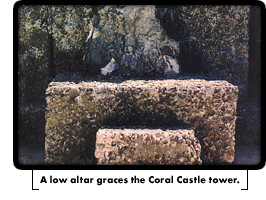 Inside the courtyard,
to the visitor's immediate right, rears a broad, square tower, with
a flight of stone steps ascending to a single doorway near the top.
They lead to the highest point in the area and a small room. This chamber
is occupied only by a leather hammock and a crude wooden table piled
with primitive tools -- chains, saws, many kinds of drills, wedges,
hammers, chisels and crowbars. Tools also festoon the walls. This imposing
tower was raised with approximately 243 tons of coral cut into cyclopean
blocks weighing from four to nine tons each. The roof alone comprises
30 one-ton blocks neatly fitted together. Although modern electricity
and plumbing are absent, oil lamps and a well of fresh water serve the
living quarters -- a sleeping chamber with twin beds, an outdoor cookery,
and a bathroom. Usually overlooked by visitors is a low but massive
altar comprising two coral blocks set against the south wall. To what
god or gods it was dedicated, no one knows.
Inside the courtyard,
to the visitor's immediate right, rears a broad, square tower, with
a flight of stone steps ascending to a single doorway near the top.
They lead to the highest point in the area and a small room. This chamber
is occupied only by a leather hammock and a crude wooden table piled
with primitive tools -- chains, saws, many kinds of drills, wedges,
hammers, chisels and crowbars. Tools also festoon the walls. This imposing
tower was raised with approximately 243 tons of coral cut into cyclopean
blocks weighing from four to nine tons each. The roof alone comprises
30 one-ton blocks neatly fitted together. Although modern electricity
and plumbing are absent, oil lamps and a well of fresh water serve the
living quarters -- a sleeping chamber with twin beds, an outdoor cookery,
and a bathroom. Usually overlooked by visitors is a low but massive
altar comprising two coral blocks set against the south wall. To what
god or gods it was dedicated, no one knows.Through a single window looking out over the courtyard below, the extent of this peculiar place can be perceived in a glance. Among its oddities is a scattering of oversized chairs made of coral, each one weighing a half-ton. Although they look extremely uncomfortable, the chairs are, in fact, exceptionally restful and balanced into perfect rockers. Remarkably, not a single tool mark has been found on any of them. A smaller number of chairs was not made to rock. These resemble contour lounges oriented to the sun after dawn and at noon. But they are not the only Coral Castle features with celestial orientations.
Strolling through the castle, I noticed numerous stone representations of planets, moons, and suns, many -- perhaps all -- of them deliberately aligned with various sky phenomena, as were the 25 huge chairs carefully positioned throughout the precinct. The site appears to be some kind of celestial observatory dating back to a time before the invention of the telescope.
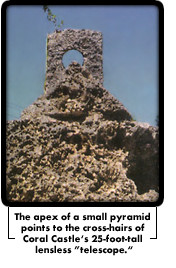 Twenty feet outside
the wall stands a lensless, telescopic structure, 25 feet tall and weighing
20 tons. Cross-hairs inside its aperture resemble those in a bombsight,
and they are aligned with Polaris, the North Star. Nearby is a massive
sundial calibrated to noon of the Winter Solstice, December 21, and
the Summer Solstice, June 21. The sundial is adjacent to a fountain
adorned with representations of the moon in its first and last quarters
and when full. On the north wall are sculpted images of Saturn and Mars.
The latter is shown next to a Palmetto plant, signifying the artist's
belief that life exists on the Red Planet. Other astronomical depictions
and alignments abound throughout Coral Castle.
Twenty feet outside
the wall stands a lensless, telescopic structure, 25 feet tall and weighing
20 tons. Cross-hairs inside its aperture resemble those in a bombsight,
and they are aligned with Polaris, the North Star. Nearby is a massive
sundial calibrated to noon of the Winter Solstice, December 21, and
the Summer Solstice, June 21. The sundial is adjacent to a fountain
adorned with representations of the moon in its first and last quarters
and when full. On the north wall are sculpted images of Saturn and Mars.
The latter is shown next to a Palmetto plant, signifying the artist's
belief that life exists on the Red Planet. Other astronomical depictions
and alignments abound throughout Coral Castle.The Castle's astronomical identity is subtly reinforced throughout the site. For example, a feature referred to by guides as the "bird bath" comprises three concentric circles 124 inches, 62 inches, and 18 inches in diameter, respectively. These measurements represent the solar system. The concentric rings correspond to the three major divisions of planets. The innermost group includes Mercury, Venus, Earth, and Mars. Jupiter, Saturn, and Uranus make up the middle group, and Neptune and Pluto are represented by the outermost circle.
An appreciation of the extraordinary labor that went into building it may be gained by inspecting this same north wall. The center section, surmounted by the representation of a crown, is the site's heaviest single block at 30 tons. Almost as massive is a 40-foot obelisk set in a hole six feet deep. In addition, Coral Castle has a 2.5-ton banquet table surrounded by half-ton rocking chairs. The stone chairs are so perfectly balanced that they continue rocking long after a light touch has set them in motion.
But Coral Castle was not built by stone-dragging slaves of an ancient civilization. No less incredible than its own stupendous construction is the fact that the entire complex was built between 1920 and 1940 by and for one man working alone and in secret. His name was Edward Leedskalnin. He was born in 1887 into a farming family at Stramereens Pogosta, a small village near Riga, Latvia, but emigrated to North America before the outbreak of World War I.
While working in a Canadian lumber camp, Leedskalnin contracted tuberculosis and fled to the warmer climate of Florida. With his puny savings, he purchased an acre of land near then-obscure Florida City for $12. Here he began building the first structures of the Castle.
At five feet tall, weighing 100 pounds, and in uncertain health, Leedskalnin would be an unlikely candidate to quarry and move the tons of coral that even a robust man would have found impossible to budge. And his fourth-grade education hardly qualified him as a construction engineer.
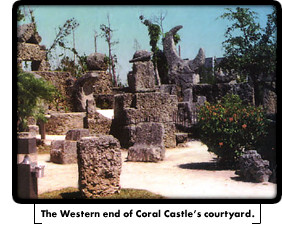 His tools were
handmade saws, chisels, chains, hoists, and hammers of the most primitive
kind, and his only mode of transportation was an ancient, dilapidated
bicycle without tires.
His tools were
handmade saws, chisels, chains, hoists, and hammers of the most primitive
kind, and his only mode of transportation was an ancient, dilapidated
bicycle without tires.Leedskalnin was a fanatic for secrecy and worked only after sundown, when he was certain no one was watching him. If anyone did stop by to inquire how he was getting along, he would immediately stop working and chat pleasantly with visitors until they left, when he would resume construction. When we consider that he cut, moved, and positioned all of the structure's megalithic blocks in the dead of night, the man's achievement assumes a truly incredible scale. Some teenagers spying on him one evening claimed they saw him "float coral blocks through the air like hydrogen balloons," but no one took them seriously. If their testimony can be believed, they were the only witnesses to the construction of Coral Castle.
In 1936, when developers threatened to set up a subdivision near Florida City, Leedskalnin bought ten acres in nearby Homestead with money saved through years of performing odd jobs for neighboring farmers. He dismantled the largely finished Castle and transferred it block by block to the new location. Each piece was placed on a pair of iron girders mounted on a makeshift truck chassis and transported over ten miles to Homestead.
For this major operation, he relied on outside help for the first and last time. He hired a tractor, but insisted that its driver not be present whenever the blocks were placed on his truck. The driver showed up at 9:00 every morning, returning in late afternoon to find the chassis loaded with coral monoliths.
Once, the driver absentmindedly returned after less than half an hour for a lunchpail he had forgotten on the seat of the tractor. He was astounded to see several multi-ton stones already laid neatly on the girders. "It was impossible to have stacked those gigantic blocks in under 30 minutes," he recalled, "even with a steam-powered derrick. And Ed had no equipment, just a simple tackle and chain hoist. Yet, there they were, piled like cord wood." Their mysterious mover was nowhere in sight, and the driver, somewhat apprehensive, left before Leedskalnin returned.
Relocating Coral Castle progressed with an easy haste. Leedskalnin accomplished this amazing engineering feat in less than a month and re-erected his stone complex, working under cover of darkness all through the night until dawn. It took him four years of unrelieved labor, during which time he added walls eight feet high and four feet wide at the base, with an average thickness of three feet. These forbidding ramparts weigh at least 6.5 tons.
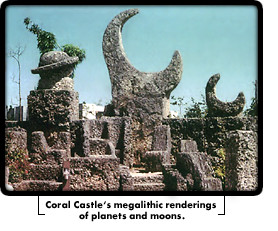 After Coral Castle
was completed, Leedskalnin opened it to restricted tours, charging 25
cents per visitor, but he preferred to live behind the great walls in
seclusion. He never shared the secret of its construction with anyone,
saying only that he had rediscovered the laws of weight, measurement,
and leverage used by the Ancient Egyptians, and that these lost principles
somehow involved the relationship of the Earth to certain positions
of the heavenly bodies.
After Coral Castle
was completed, Leedskalnin opened it to restricted tours, charging 25
cents per visitor, but he preferred to live behind the great walls in
seclusion. He never shared the secret of its construction with anyone,
saying only that he had rediscovered the laws of weight, measurement,
and leverage used by the Ancient Egyptians, and that these lost principles
somehow involved the relationship of the Earth to certain positions
of the heavenly bodies.Leedskalnin is quoted as saying, "I have discovered the secrets of the pyramids. I have found out how the Egyptians and the ancient builders in Peru, Yucatan, and Asia, with only primitive tools, raised and set in place blocks of stone weighing many tons." The very stones of Coral Castle support his story -- at an average of six tons, they are twice the weight of the blocks in Egypt's Great Pyramid at Giza.
Carrol A. Lake, a colonel in the U.S. Army Corps of Engineers, stated that "Leedskalnin proved for all the world to see today that he knew the construction secrets of the ancients." He was seconded by one of America's leading investigators, Vincent H. Gaddis, who said of the mysterious Latvian immigrant, "There is no doubt that he applied some principle in weight lifting that remains a secret today."
Even the purpose of Coral Castle was deliberately obscured. When asked why he assumed such an enormous undertaking, Leedskalnin smilingly explained that it was built entirely for his "Sweet Sixteen," Agnes Scuffs, a woman he once asked to wed, but who never left Latvia, where she married even before he arrived in Florida. Revealingly, he never contacted Agnes after coming to America. He seems to have used this tale to politely put off unwanted curiosity.
Little is actually known about Leedskalnin, a friendly though private person. His dedicated isolation once got him into trouble, however, when he was beaten by a gang of local yahoos who threatened to kill him if he did not divulge the location of what they believed was a treasure hidden inside Coral Castle. He suffered their savagery and told them nothing. After his death, $3,500 was found in the tower -- his life savings, mostly from land sales -- but that was all.
Leedskalnin's work was his life. Material pleasures meant nothing to him, and he merrily subsisted on a diet of sardines, crackers, eggs, and milk. His meager garden produced green vegetables and some fruits, and he trapped the occasional rabbit. He worked tirelessly from sunset to sunrise and spent much of his day reading from his library about magnetic current and cosmic forces, resting only a few hours in the late afternoon.
Leedskalnin passed away in his sleep in 1953, of malnutrition and kidney failure. His only living relative, Harry, inherited what was then known as "Rock Gate Park." Shortly before he died, Harry sold the property to a Chicago family, who gave it its present name. Thirty years later, Coral Castle was placed on the National Register of Historic Places.
Nearly six decades later, Leedskalnin's marvelous home is still explored each year by thousands of visitors from across the country and around the world.
Coral Castle has attracted the international attention of professional construction engineers, astounded and mystified by the apparently impossible achievement of this diminutive wonder-worker. In the mid-1970s, for example, a large bulldozer was hired to manipulate a coral block equivalent to the Castle's 30-ton monolith; the bulldozer could not even lift it.
Alternative science investigators suggest that Leedskalnin somehow learned the secret of the "world grid," an invisible pattern of energy lines surrounding the Earth which concentrates points of telluric power where they intersect. It was here, at one of these intersections of Earth energy, that he was supposedly able to move his prodigious stone blocks using the unseen power of our planet. In fact, in The Enigma of Coral Castle, Ray Stoner suggests that Leedskalnin moved the Castle not because it was threatened by an encroaching subdivision, but because a surveying error misplaced the site ten miles from an Earth energy vortex or focal point. In order for the structures to maximize this energy, the entire complex needed to be relocated in Homestead, where the telluric forces were focused.
Bruce Cathe, in The Energy Grid, one of the most credible books on the subject, says "the site of Coral Castle is mathematically related to the world energy grid, as are the other remarkable structures which, however, date from ancient times. Ed Leedskalnin had not moved on to the Florida site by chance. This geometric position was extremely close to one that would be ideal for setting up harmonics related to gravity and light harmonics. The fact that [he] had access to secret knowledge is much more evident in the relationship of Coral Castle to the world energy grid system."
Stoner says some fundamental conditions must be met before a structure like Coral Castle can be made to function as intended. It must be exactly situated over an energy vortex, aligned with a celestial event or events sufficiently precise to predict their recurrence, constructed in a specific shape, and built with certain materials. Finally, activities at the site may be successfully undertaken only at the moment the celestial events to which it is oriented take place.
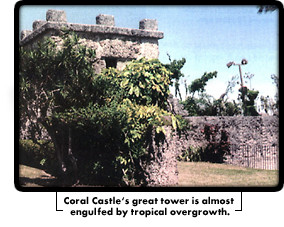 Stoner's prerequisites for particular shapes and building materials
are reminiscent of experiments in pyramid power in the mid-1970s, when
the precise angles (variants of 15.2 degrees) of the pyramid and its
special construction elements (crystalline granite and non-conducting
limestone) determined their success. In Using Pyramid Power,
James Wyckoff writes,"The ancient Egyptians knew that the shape and
angle of pyramids contained a mystical energy force."
Stoner's prerequisites for particular shapes and building materials
are reminiscent of experiments in pyramid power in the mid-1970s, when
the precise angles (variants of 15.2 degrees) of the pyramid and its
special construction elements (crystalline granite and non-conducting
limestone) determined their success. In Using Pyramid Power,
James Wyckoff writes,"The ancient Egyptians knew that the shape and
angle of pyramids contained a mystical energy force."Traditions from various parts of the ancient world describe levitation as the construction means used by the unknown builders of miraculous structures. In Britain, Merlin was said to have originally found Stonehenge in Ireland, where, like Ed Leedskalnin, he singlehandedly took apart its massive stones and transported them through the air to England's Salisbury Plain. A world away in distance and time, the South Pacific islanders of Ponape still tell how the 20-ton basalt column of Nan Madol, an enormous megalithic site, were floated across the sky by two Merlin-like magicians. Recalling the teenagers' report of multi-ton blocks floating through the air, it may be easier to believe that Leedskalnin was using Earth energies after all.
Cathe suggests that "at certain positions on the globe there are localities where the forces of gravity can be manipulated by the application of certain geometric harmonies. Where these geometric conditions exist, it is evidently possible for people who have the knowledge to use gravitational forces to construct great buildings of massive material. Stonehenge, the ancient pyramids, the temple at Baalbek, and perhaps the pyramids in Central and South America were the results of a combination of knowledge and gravitational anomalies. Coral Castle, I believe, occupies one of these positions."
But how Leedskalnin built Coral Castle is no more mystifying than why he did it. He had little interest in money, consistently resisting efforts by entrepreneurs to advertise his place and turn it into a tourist attraction. Indeed, outsiders could gain entrance only after pulling on a bell cord, to which he may or may not have been in the mood to respond. He rarely left the site, and what he did behind its sheltering walls no one ever knew.
Like the enigmas of its construction, its real function is unknown. Why did he make so many sculpted references and astronomical orientations to the heavens? For whom were 25 half-ton rocking chairs designed? To what or whom was his barbaric altar dedicated? What need could have demanded so massive a complex as Coral Castle? And why did Edward Leedskalnin devote his whole life to it?
Today, Coral Castle is open to the public as the self-made monument of a reclusive man's mysterious genius.
Frank Joseph is the editor of Sacred Sites: A Guidebook to Sacred Centers and Mysterious Places in the United States and Canada. He lives in Wisconsin. For further information, visit his web site, Ancient American.
© Copyright 1998 Llewellyn Worldwide, Ltd. Reprinted with permission.
FATE Magazine is published monthly by Llewellyn Worldwide, Ltd. Subscriptions are $21.50 per year; call 1-800-728-2730 or write to P.O. Box 1940, 170 Future Way, Marion, OH 43305. You can e-mail FATE at fate@llewellyn.com, or visit FATE's website at http://www.fatemag.com/
 |
Enigma: Paranormal Phenomena |
 |
Paranormal message board: Share your views |
 |
The ParaStore: Books on the Unexplained |
 .
..